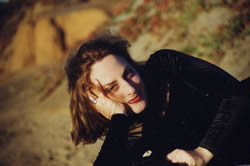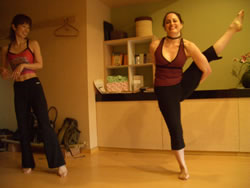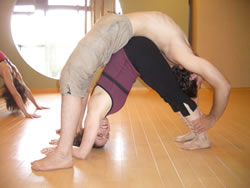 |
 |
 |
 |
 |
 |
 |
Leza Lowitz, Writer, Poet, Yoga Teacher and Healer
Interview in Tokyo on her new book "100 Aspects of the Moon," poetry and yoga.
Leza LowitzAward-winning multi-genre writer Leza Lowitz has published more than seventeen books, including the Amazon best-selling title, Yoga Poems. Her numerous awards include the PEN/Oakland Josephine Miles Poetry Award, a PEN Syndicated Fiction Award, grants from the NEA and NEH, and the Japan-U.S. Friendship Commission Prize for the Translation of Japanese Literature from Columbia University. Her writing has appeared in the Huffington Post, Shambhala Sun, Harpers, Best Buddhist Writing,the New York Times online, and on NPR's "The Sound of Writing."
She is also a yoga teacher who owns and directs Sun and Moon Yoga in Meguro, Tokyo. After a decade in California, Lowitz recently returned to Japan to open the yoga studio… She continues to write and also works as an editor at the Japan Foundation. In addition to writing, editing and teaching, she conducts workshops on yoga, writing and creativity.Q. You’re a yoga teacher, and a writer of fiction and poetry as well as an editor. Can you talk about some of the ways that writing and yoga intersect?
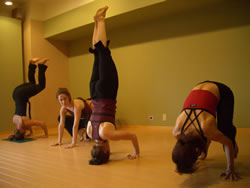
Leza doing a headstandThe ancient holistic system of yoga, which is quite popular today as a meditation and healing art, helps us to open our hearts, recovering our emotional core and connection to the world through breath, movement, and awareness. Poetry, called the “original breath,” seeks to do the same through words, images and sound. Like yoga, the alchemy of poetry awakens the soul, changing the way we see ourselves and the gifts of the universe. For me, that’s where the transformative paths of yoga and writing converge. When I practice yoga, I quiet my mind and my creativity flows. I get inspired by the postures themselves—just think of the richness of the names and shapes of the poses—Tree, Bridge, Mountain, Eagle, Sun Salutation, Monkey….there are over 840,000 yoga poses, and every one is new each time you do it. It’s this process of discovery that is similar to creating art.
Writing, like yoga, brings us to this state of stillness, of inner listening. The writer goes back to this place of stillness, over and over, and records what she hears within. In yoga, the main thing one needs to do is show up at the mat. In writing, the blank page is the mat. It’s a reflecting pool, a mirror of our innermost psyche. And like in our yoga practice, when we write, we can also experience moments of challenge and discomfort. But we sit with it and break through. That is when art is born.
Q. So is writing a kind of yoga?I’ve been writing since I was 8, and I’ve been practicing yoga for over a decade. Both were born from the need for release and to break free of past bonds I had been struggling with liberating myself from.
I had started martial arts training when I was a teenager, because I was beaten up a lot and suffered abuse in my family (both physical and emotional) and I wanted to be strong and learn to defend myself and be able to stand my own ground. I could do that, but I also found that what I had developed in the course of that work was a very strong emotional and physical armour. I was too tough. Too protected. Too frightened inside. So for me, yoga was the most powerfully cathartic tool for self-transformation because it allowed me to face that fear that I had been hiding from within myself.
While I was stretching and twisting, breathing and calming my mind and body, I discovered places in my body that were very stiff, and I also discovered incredible reserves of strength, stamina and newfound flexibility. I discovered that the physical and emotional traumas and violence I had experienced as a child (and also from past life karma that were playing themselves out in this life) were stored in my body’s cellular memory. As a result, I had a lot of subconscious blocks, which
yoga helped me to release.Even though I had done a great deal of work with psychotherapy over the years, and deep emotional healing, including deep bodywork, transcendental meditation, past life regression work, outward bound, inner child healing, psychic release, shamanic rituals, Reiki, etc, etc, etc, yoga was finally what really helped me unearth and release these traumas from my physical body. It also taught me to trust, to step into the unknown. By discovering where emotions are stored in the body, we can work to accept them and not push them away.
If we walk into the difficulty, we can breathe through it and release these emotions and traumas. That was what was so powerful for me about yoga. But I had an amazing teacher who herself had gone through the fire, and you could tell. She was really there for us when we were fighting our own demons. And that is how I hope to be as a teacher. That is one of the cornerstones of my teaching–to give people a safe place to explore whatever emotions, feelings and memories surface in the course of breathing and opening our bodies, and to embrace them, honor them, process them, and let them go. And, when we release these blocks, we find a newfound capacity for creativity and unconditional love–for ourselves, and for others. That is when we destroy the illusion of separateness that causes so much suffering. As the Navajo say, “We are all connected.” We have forgotten that. Yoga helps us remember our unity from a deep level.
R.K. Narayan, the Indian novelist (1906-2001), said: “You become a writer by writing. It is a yoga.” Writing, like all art, is an act of faith, a commitment to your deepest self-expression. In fact, creativity itself is prana, coming mainly from two energy spheres–the second, sacral chakra or Svadhisthana (which means “sweetness” in Sanskrit), and the fifth, throat chakra or Vishudda (“purification” in Sanskrit). Creative energy is brought in through the second chakra, and then it is processed, and sent out into the world through the fifth chakra, which is our center of self-expression. So if I want to open to my creativity, I work in the second chakra doing hip opening poses, and then I focus on the fifth chakra to open the throat. Some good poses to work in the fifth chakra are shoulderstand and fish–anything that softens the throat and opens the heart. Chanting is also amazing for this reason, and so is deep breathing.
Q. Why is poetry important in this day and age?
Poetry comes from poein, from the Greek word “to make” or “to change.” Poetry transforms the world of the particular into the universal. It takes ordinary events and looks at them in an extraordinary way. Poetry is a kind of alchemy and magic. It touches the soul on a deep level and enacts its own wisdom. Many cultures print a poem daily in the newspaper, feeding the cultural soul. It’s interesting to note that after 9/11, much of the world, and America in particular, immediately turned to poetry on the news, internet, radio. It was instinctive. It was an immediate, visceral response. Nothing else seemed to capture the intensity and feeling of the moment. Poetry helps us get back to that sacred and connected place. We need to reconnect to that place.
Another reason that poetry is important is because it connects us to the ORIGINAL BREATH. Speech and expression are only possible in the exhalation, the dying breath. Poetry is scoring the dying breath. Poetry has the psychic, intellectual, and erotic ability to imbue that dying breath with meaning. If you think of it literally, each poem is your last breath! Poetry is powerful because it returns us to the indigenous connection to the earth—nature, the seasons, living and dying. We’ve lost that connection. Poetry helps us record what’s unrecorded, expresses our authentic kinship with the world. It links us to our original, primordial condition, which is sacred. It is revelatory. It REVEALS and uncovers the original heart/mind.
Furthermore, deep writing, like yoga and meditation, is a process of stripping away illusion. When we write creatively, we’re connected to ancient energies. These connections give our immediate experience a resonance that is larger than the moment, larger than our personal stories, egos, or individual “little selves.”
Q. How do you have so much energy for all these projects you do? And, is there a best time to write?
Basically, energy is flow. Yoga and other self-transformational practices teach us how to work with our energy; essentially to work with the flow instead of against it. And so that’s what I do….I read somewhere that there are 14,440 minutes to the day….that’s a lot of time! Much of the work that I am publishing now I have been working on for years and years and years. For every book I publish, there is one sitting yet unfinished, so I have a lot of material to develop. Of course, much of it ends of discarded.
As for the best time for writing, basically, you can wait for the muse to visit (you may be waiting for a very long time!!!), or you can sit down and get to work each day, facing the blank page. It’s just like yoga, showing up on the mat and greeting whatever comes….or doesn’t. You learn from that, too.
Like meditation, writing is best done at a quiet time so you can listen to yourself, as if listening intently to music. Morning is best, when the brain has not yet been infiltrated by public space, TV, language, or external stimulation. There’s a sense of open-ness, a clean slate quality, when the mind is closer to the unconscious, almost in a dream state. That’s when art can emerge.
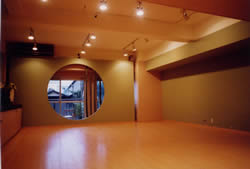 |
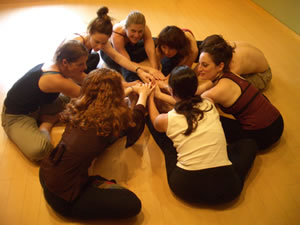 |
Leza’s Sun and Moon Yoga Center in Meguro, Tokyo, Japan.
Q. You have a new book of poems coming out, called “100 Aspects of the Moon.” Can you talk a little bit about your new book? And, by the way, isn’t that the name of a famous woodblock print series?
Yes. You’re right. The woodblock series is by Yoshitoshi Tsukioka. I wrote many of these poems in the year I was turning 40. I wanted to mark a passage, to commemorate a life cycle shift. The Goddess Luna, the feminine embodiment, spoke to me and inspired me. In this day and age, when so many structures are crumbling, I felt drawn to cohesion in a way I’d never felt before. So I decided to structure the book around the moon as a motif. I was inspired by the American poet Jane Hirshfield’s lovely book of poems, The Lives of The Heart, in which she made her project one of connection through the heart in each of the poems.
I had always loved the haunting woodblock print series of Yoshitoshi. In the age that Yoshitoshi was painting in (1839-1892), Japan was in a period of great modernization. Western methods like photography and lithography were adopted, and Yoshitoshi used the traditional ukiyo-e method influenced by modern ways of seeing, capturing the flux of the era. Though he first painted violent scenes depicting warfare and bloodshed under the Tokugawa Shogun, Yoshitoshi soon found himself broke and destitute, living with a mistress who first sold her clothes and possessions to support him, then finally sold herself to a brothel, as did his subsequent mistress. Suffering from mental breakdowns and delusions, Yoshitoshi nonetheless persevered in his art, breaking with the conventions of the ukiyo-e carvers of the times.In “100 Aspects of the Moon,” he revolutionized the form. His use of heavy brushstrokes, intricate patterning, Western perspective, and mostly, the amazing content of the series, which ranges in subject matter from geisha to samurai to wolves to the Goddess Kwan Yin (showing people freely from all angles), were extraordinary. The only link between these disparate subjects is the moon, shown in many stages. But as scholar John Stevenson has pointed out, the series is less about the moon and more about human beings and the emotions shown in important events in Japanese and Chinese history and mythology. The series also illuminates simple scenes of everyday life. Nowadays, the prints in the series are traded and collected worldwide, even on the Internet. Each print is vibrant and unique.
But no one can own the moon. No one can harness and contain the mysterious, overwhelming power of the feminine. We can only glimpse its glorious phases, even using the most advanced technology. So while the inspiration for this book was Yoshitoshi’s series, the impetus was my own life crossroads at the end of the twenty-first century, at a turning point in my own life. My own eclipse, so to speak. So I decided to adopt his structure and write poems around the moon to commemorate that shift.
Q. What was it about the moon that drew your interest and made you want to structure a book of poems around it?
I wasn’t looking for a theme, but I was looking for a way to connect experience, cultures, times and places, and the feminine instinct seemed a natural place for me to explore, a healing, nurturing energy to embrace. In ancient times, when people lived closer to nature, the moon was seen as a symbol of the Goddess, and the light of the moon was considered magical, a source of energy. In many cultures, the Moon Goddess and the Creatress were one and the same. Polynesians called the Creatress “Hina” or Moon. She was the first woman, and every woman is made in her image. And the root word for both “moon” and “mind” is the Indo-European word manas, which symbolizes the Great Mother’s “wise blood” in women, governed by the moon.
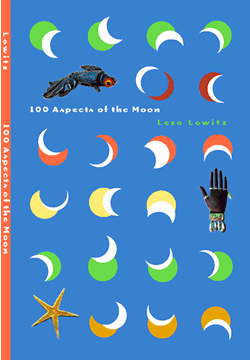 |
100 Aspects of the Moon, poetry and yoga
As Djoharia Toor writes in The Soul of Passion, “The night the moon rules over represents our ability to bypass the linear mind, for a while anyway, to ponder and feel the mystery within. The night, in essence, represents knowledge based on the passive-receptive side of the feminine.” And I think that is what I wanted to embrace—that passive-receptive energy. I have spent a great part of my life utilizing my Yang energy, and now I felt drawn to the Yin.
Naturally, we tend to avoid the dark places, since they usually hide fearful things, or things we are afraid of. And yet, if one is to know oneself deeply, and to be able then to know others, those places must be ventured to. The night must be walked in. To craft poetry is to lift the veil and then to deconstruct, reconstruct, shape and illuminate– especially the places that scare us. Some of these poems go there–plumbing the past, uncovering memories or trauma. Some explore the act of writing poetry itself. Others look beyond the personal to universal themes. Here, “100” is a metaphor for “myriad,” since there are thousands of ways to view the moon.
Q. Many of the poems are set in Japan. Was being in Japan conducive to writing moon poetry?
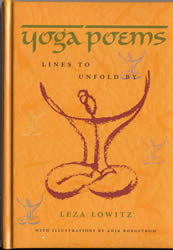 |
Amazon bestseller Yoga Poems
Actually, the poems in this book chart forty years of experience, ranging in locale from Japan to America to Croatia, lands I visited or had some connection to friendship or through social action. Some are free verse, experiments in form, homages to writers, artists and jazz musicians. Others are offerings to places of moon-viewing around the world, in times of peace and war.
It’s true that the Japanese culture lends itself to poetry, and it has always embraced the moon’s cycles in its art and literature. Japanese architecture even has special windows for viewing the moon. This is a way to frame and to honor the waxing and waning, a way to reflect on the inner cycles through nature, to illuminate the darkness through the moon’s light. A poem, too, has a way of illuminating the darkness, a way of breaking your heart. Suddenly, you see something in a different light, look at it in a new dimension, feel a moment more deeply, or see something ordinary in an extraordinary way. It’s a portal.
Home
•
Naturopath •
Aromatherapist •
SHOPPING ONLINE • Contact
Us
Healers,
Teachers & Creative People • Magazine
- Online • Useful
Info
Meditation,
Mantras & Prayer • Vegetarian
Info • Famous
Vegetarians •
Links

